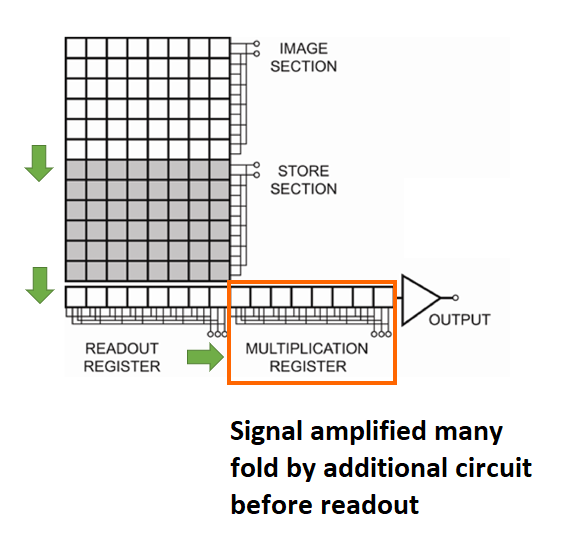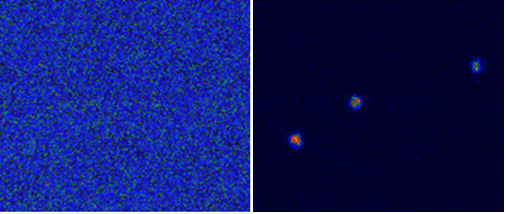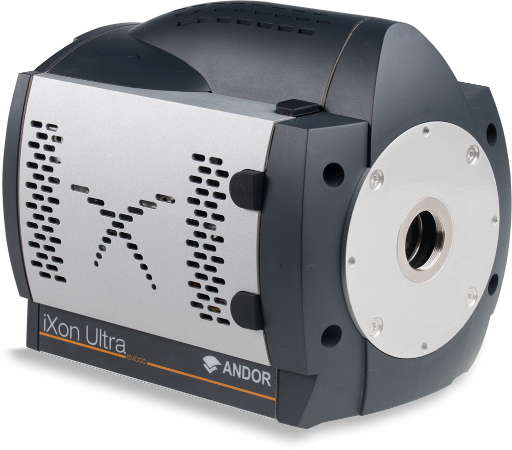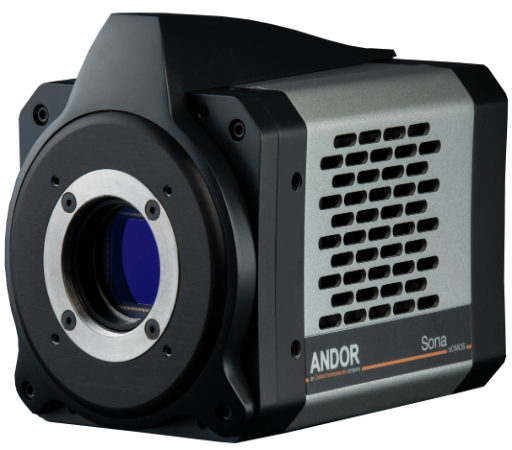Resources
 Part of the Oxford Instruments Group
Part of the Oxford Instruments Group
Expand
Collapse
 Part of the Oxford Instruments Group
Part of the Oxford Instruments Group
In this article we discuss some common misconceptions about EMCCD cameras, and separate fact from fiction. We asked some common questions about EMCCD cameras to Andor Camera specialists Dr Adam Wise and Dr Alan Mullan.
AW- Sure - “EMCCD” stands for Electron-Multiplying Charge-Coupled Device. The key part here is “Electron-Multiplying” - electrons can be moved around with electric fields, and when they zip around fast enough and hit something, releasing more electrons. For example, start with one electron, repeat this trick a few times, and now you have a lot of electrons. A lot of electrons are – unsurprisingly – much easier to measure than one electron. A similar method has been used for a long time to measure light using photomultiplier tubes (PMTs), but here it is all happening in a silicon light sensor of a type called a CCD. There are also single-element detectors called APDs that exploit a similar effect to measure very small light signals. That’s the key difference between the EMCCD and any other camera technology though – the ability to amplify electrons in the sensor itself to measure very, very small signals – down to single photons.

Figure 1: The EM gain register of an EMCCD camera enables even the faintest signal to be boosted many times in excess of the background noise for exceptional Signal to noise.
AM - It really shouldn’t be more complicated to use an EMCCD over a sCMOS detector- but some of the complexity comes down to how the camera functions are implemented in the acquisition software. If it is an sCMOS or EMCCD camera you have different acquisition options other than exposure and the size of the region imaged. These will affect what speed the camera can run at- so how many frames per second or Hertz and the dynamic range - that’s the weakest to the brightest signal in the image that it can handle before saturation. Ultimately it is how these imaging options are presented to the user in the software that will make imaging easy to understand or not. I think that most modern software whether that’s our own, or that from third party options have focused on ease of use in recent years improving usability.
For example, we introduced a feature called Optacquire into our software which was a handy way to set the camera up for e.g. fast or very long exposure imaging and the setting of the camera would automatically adjust to suit what would work best.
AW - There are diminishing returns to more and more EM gain. The ideal amount to use is as little as possible. For most applications, this means using an EM gain equal to the read noise of the sensor, which effectively reduces the read noise to 1 electron. The upside of more EM gain is, well, probably obvious: you amplify your signal a lot, and this makes it easier to detect. The downside is less obvious: when you amplify your signal more, you’re creating lots of electrons they must be stored somewhere before getting counted (or “read out” as we often say). That storage space is called “EM Gain Register Depth” in our spec sheets. Eventually that storage space can fill up (or “saturate”), and that might happen before reaching the maximum signal you want to measure. When EM gain is very high that can happen quickly. On the other hand, when EM gain is used in moderation it will leave more space for a wider range of dim and bright signals. We can quantify this in terms of Dynamic Range – the ratio of the largest to smallest measurable signals. We might really care about maximum dynamic range – for example when doing quantitative fluorescence measurements. Or we might not care at all – if we’re doing single photon measurements, we might just be looking for “photon” or “no photon” and want maximum sensitivity.
AW - I think it’s important to treat EM gain with respect, but “worried” is not necessary. It is certainly something that happens, but under normal circumstances it takes many years to make a practical difference. The primary reason to use a minimal amount of EM gain is to preserve dynamic range that I talked about before, rather than to avoid gain aging. We routinely see cameras in the field that are ten or more years old, have been used daily and are still perfectly functional.
AM - I’d echo Adams comments on this issue being a non-starter as a concern. I think some of this has been drawn out by camera manufacturers that do not have a good EMCCD option, as you try to look for an angle to direct people towards the other solution that you do provide. Since we have both good EMCCD and sCMOS camera options we would hope it is the application needs that dictate what camera is required.
There are many iXon customers with older models that could be 10-15 years old, and they are still using their camera without any problem as has been said. It may only be updates to software and PCs that force them to a newer model. So, I think this settles this myth around EMCCD.
AM - I see that being claimed but it is wrong, or certainly the context of it is misleading. EMCCD and sCMOS do have comparable high peak QE (90-95%) so that is their ability to convert photons into electrons which is up to 95% efficient. But what happens after this in the sensor is different and this is what makes EMCCD the most sensitive detector when you really need it... at low light levels. Again, this is due to being able to use the electron multiplication of the EMCCD camera to boost that signal up to say 1000-fold before it gets read out by the camera as Adam has described. At low signal levels this means the EMCCD camera boosts the signal many times so it can read out a very high signal well above the noise of the camera, so the read noise is itself negligible. For a CMOS based camera, even with the high QE ability, a low-level signal is not going to be boosted in this way and will not increase above the noise of the camera, so it will not result in useable data.
AW - This is something that is easy to demonstrate if we compare the different cameras in an objective way. Many have already done these comparisons with the latest models and when the sensitivity at low photons levels is required, as in single molecule detection experiments, or live-cell confocal. More often than not, the iXon EMCCD camera delivers better results. EMCCD cameras allow reliable quantitative measurements and photon counting needed for quantum and biophysics applications at these light levels. sCMOS is just not capable in the same way.
AM - another thing I also wanted to mention was that often we are taking about peak QE. If we move off of the peak QE, the EMCCD cameras have options for high QE extending in the blue or NIR ranges. CMOS sensors for microscopy tend to have a peak in the visible range that drops off either side.

Figure 2: EM Gain of EMCCD camera (right) means signals can be detected that are not possible to be detected by just high QE and low read noise alone (left).
AW – Some of this might be beyond the scope of this conversation. There is much more info in our learning center article on noise sources in EMCCDS. The short answer is that EMCCDs show a small amount of additional background noise called “clock induced charge” or CIC. These show up as an extremely weak “salt and pepper” background – a few random counts that fluctuate from image to image, with a very low per-pixel probability. You should be aware of this phenomenon so as not to be surprised by it, but keep in mind that sCMOS cameras have a variety of other noise sources as well that are often more problematic. As well, the EM gain mechanism that I described above is stochastic – n electrons go in, and usually (n*gain) electrons come out, but sometimes it might be slightly higher or slightly lower than the average. The amplification is high, but we may have a small amount of uncertainty as to how many electrons we started with. This uncertainty is called the “excess noise factor” and you can see how it affects measurements here.
AW - So I described the “trick” of EMCCDs above – drop an electron through a potential and when it “hits”, a puff of more electrons is released. As you can imagine, this is something of a random process in that you might knock off 0, 1, or 2, or more electrons for each one in during every cycle. At the end of many cycles of amplification, there’ll be some uncertainly about how many electrons we had when we started. We call this uncertainty the “Excess Noise Factor”, or ENF, and in EMCCDs it’s quantitatively sqrt(2) - that is to say the ratio of the standard deviation of the “signal out” vs the “signal in” is sqrt(2). In some applications, this can make the camera act as if it had a lower quantum efficiency.
However, in photon-counting applications we’re not overly concerned about this quantitative uncertainty – we want to know whether we captured a photon or not, and so long as we can raise a single event above the detector’s background noise, which we can do with EMCCD we’re quite happy.
AW – yes, it’s still an important technology especially in terms of uniformity and low dark current. I don’t see that changing anytime soon.
AM - very much so! We would say no one camera does it all –whether this is for microscopy or any of the other areas of imaging. The CMOS based cameras have a very good set of attributes suit as low noise, high speed and wide field of view that makes them more suitable for many applications. But EMCCD, and also the deep cooled CCD cameras, still work well for certain applications.


Figure 3: EMCCD and sCMOS cameras may be selected depending on the needs of different imaging experiments.
AM - The iXon EMCCD cameras are the main camera used for single molecule studies. SCMOS is used in some studies of course, but the EMCCD camera is just better suited to working with these really weak signals. The EMCCD can prove faster in practice- for example you may need a 2-4 fold increase in exposure time with sCMOS cameras compared to the EMCCD.
Another area for EMCCD, and also deep cooled CCD, is for luminescence experiments using luciferase reporter systems. These kinds of experiments use exposures of many seconds or minutes, and this is one area that the CMOS technology sensors are just not good at. The problem is dark current- that is noise generated within the sensor itself that increases over time. We can cool the sCMOS cameras down like in the Sona-6 series or a Neo sCMOS and maximize the useable exposure and reduce other blemishes of the sensor, but the dark current still becomes a problem as we pass 2-5 seconds and gets worse very quickly. Luminescence signals are very weak and to do these experiments you need to keep the background noise as low as possible and capture the signal over a long exposure. The EMCCD and deep cooled CCD have 100-fold lower dark current than the CMOS so they can acquire a very weak luminescence emission over extended periods of the many seconds or even 20 minutes with a low background. So, for these kind of applications like in vivo luminescence where you are studying gene expression over long durations you really need an EMCCD (or deep cooled CCD).
AM - I think another one is for people that have an iXon or other EMCCD camera that is say 10 years old and working well – are they going to get any benefit from one of the new models like an Ultra 888 or Life model, or should they move to some new sCMOS model? I would say it is changes to the PC like for example -Windows 10 and supported hardware and controller cards of these older models that is the main issue. Performance wise, moving to a newer iXon Ultra model will give better performance- the electronics are updated and refined over time so there will be less noise and it will be faster. If it’s one of the models with a small sensor size, then an iXon Ultra 888 has the same sensor area as the popular sCMOS format so will boost the field of view too. If their imaging has changed- maybe looking at lower magnifications, or they don’t need to use EM gain/or use only a low gain, then that would be a possibility to change to an sCMOS and worth demoing the new EMCCD and sCMOS to decide.
AW- Some common questions I get that haven’t been really answered above are “What camera settings should I start with?” and “Why am I saturating at a certain signal levelI highly recommend you check out our wonderful Optaquire feature, which is basically a wizard that will give you a good starting point for acquisition settings based on the particulars of your sample or experiment. CCDs in general, but especially EMCCDs, have a good number of adjustable parameters for acquisition compared to sCMOS cameras. This gives us extra flexibility at the cost of some complexity, and I believe this is something to at least think about when choosing equipment.
Adam Wise, PhD
Adam is a Field Applications Specialist, based in the greater Philadelphia region of the eastern United States. His academic research was focused on Raman and single molecule photoluminscence spectroscopy of conjugated polymers, earning his Phd with John Grey at the University of New Mexico in 2012. Since leaving academia he has stayed in the orbit of spectroscopy and optics, mainly in instrumentation. Please feel free to contact him with any scientific imaging or spectroscopy questions.
Alan Mullan, PhD
Alan is a Product Specialist for Microscopy Cameras at Andor Technology based in Belfast, Northern Ireland. This keeps Alan in touch with the imaging needs of researchers in many different areas of research as well as the latest developments in imaging sensor technology. Alan’s own research background is in microbiology, which included developing techniques for imaging and characterizing transport systems and intracellular polymer metabolism of bacteria linked to important environmental and infection processes. After academia, Alan spent time working in the medical diagnostics, food and pharmaceutical industries in application and technical roles before joining Andor Technology.
Date: July 2021
Author: Dr Alan Mullan & Dr Adam Wise
Category: Technical Article
